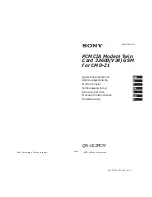
Section 6
DATA TRANSFER
Copyright (C) Dataplex Pty Ltd
6-1
6.0 DATA TRANSFER
6.1 Error Control
In synchronous applications, typically with mainframe computers, communications
software running in the front end processor and terminal is responsible for error control. In
asynchronous communications with mini, micro, and personal computers, there is usually
no link level error control and users occasionally experience corrupted data in keyboard
interactive sessions. For file transfers, most async communications packages support an
error correcting protocol such as Xmodem. This protocol, and others such as Ymodem,
Zmodem and Sealink offer error correction only during the file transfer phase. Problems
will still be experienced on noisy lines during the set-up phase if the link is not error
protected.
MNP (Micro Networking Protocol) provides continuous error control during keyboard
interactive sessions and file transfers. When these error corrected protocols are active,
ASCII file transfers are sufficient and invoking the additional error protection of Xmodem
is often unnecessary and only serves to slow down file transfer.
Error Control is achieved by building packets of characters from the sending terminal, then
calculating and appending a Cyclic Redundancy Check (CRC) character. This information
is transmitted over the communications channel which will often have noise (electrical
interference). This noise will corrupt the data and produce errors. At the receiving
terminal, the packet is analysed by the same CRC algorithm and the CRC is locally
computed. If the two CRCs do not match then an error has occurred and a Negative
Acknowledgment (NAK) is sent and the block is requested again. If the CRCs match, a
Positive Acknowledgment (ACK) is sent and the next block is sent. Retransmission takes
place repeatedly until the block is received error free. Once the block is received error free,
the next block is sent.
In simpler block-at-a-time protocols, such as Xmodem, a block is sent and then the sender
pauses until an ACK or NAK is received. On satellite or long delay links this seriously
reduces throughput and therefore go-back-n or sliding window protocols are preferred.
Such protocols number each block and send blocks repetitively until either the preset
maximum is reached or an ACK or NAK is received from the remote modem. An ACK
signal contains the number of the last successfully received block. In the event of an error,
all blocks that followed the block in error are retransmitted. In very sophisticated systems,
Selective Block Retransmission sends only the block in error and the receiving device
resequences the data stream before releasing it to the terminal.
The DPX-213 features extended MNP allowing selective retransmission when connected
to another DPX-213 modem for higher throughput.
Summary of Contents for DPX-213
Page 6: ...VI Document No 113 213 01 Rev 1 0 THIS PAGE INTENTIONALLY LEFT BLANK...
Page 10: ...INTRODUCTION Section 1 1 4 Copyright C Dataplex Pty Ltd THIS PAGE INTENTIONALLY LEFT BLANK...
Page 18: ...INSTALLATION Section 2 2 8 Copyright C Dataplex Pty Ltd THIS PAGE INTENTIONALLY LEFT BLANK...
Page 22: ...BEFORE YOU START Section 3 3 4 Copyright C Dataplex Pty Ltd THIS PAGE INTENTIONALLY LEFT BLANK...
Page 48: ...AT COMMAND SET Section 4 4 26 Copyright C Dataplex Pty Ltd THIS PAGE INTENTIONALLY LEFT BLANK...
Page 56: ...APPLICATIONS Section 5 5 8 Copyright C Dataplex Pty Ltd THIS PAGE INTENTIONALLY LEFT BLANK...
Page 76: ...S REGISTERS Section 8 8 10 Copyright C Dataplex Pty Ltd THIS PAGE INTENTIONALLY LEFT BLANK...
Page 82: ......
















































